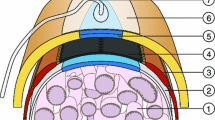Abstract
Abdominal wound dehiscence (AWD) is one of the most notorious complication after laparotomy and associated with high morbidity and mortality. The retention suture is used in the re-operated cases of wound dehiscence to reduce the disruption of fascia. To study the effect of prophylactic retention sutures in patients with high risk for wound dehiscence who underwent midline laparotomy. Random selection of 200 midline laparotomy cases was done divided into two groups. In the one group (Cases- group A) Conventional mass closure of midline fascial wound closure with incorporation of prophylactic retention sutures. In other group (Control group - group B) midline line fascial closure by conventional mass closure without incorporation of prophylactic retention sutures. Comparison of both the techniques regarding preoperative status and postoperative complication such as incisional hernia, wound dehiscence and chronic wound pain was done according to clinical examination and recorded in the pro forma prepared. Incorporation of prophylactic retention sutures reduce the occurrence of WD following midline laparotomy in high-risk patients with multiple risk factors for impaired wound healing without imposing remarkable post-operative complications.


Similar content being viewed by others
References
Riou JP, Cohen JR, Johnson H Sr (1992) Factors influencing wound dehiscence. Am J Surg 16(3):324–328
Zhamak et al (2012) Prophylactic retention sutures in midline laparotomy in high risk cases of wound dehiscence: a randomized controlled trial. Assoc Acad Surg 178(11):110–115
Armstrong CP, Dixon JM, Duffy SW et al (1984) Wound healing in obstructive jaundice. Br J Surg 71(6):267
Gialson H, Gronbech JE (1995) Burst abdomen and incisional hernia after major gastrointestinal operations and comparison of closure techniques. Br J Surg 51(4):154–159
Macdougal BA (1995) Locking a continuous running suture. J Am Coll Surg 18(1):563
Medical Dictionary for the Health Professions and Nursing © Farlex 2012
Spiliotis J, Tsiveriotis K, Datsis AD, Vaxevanidou A, Zacharis G et al (2009) Wound dehiscence is still a problem in the 21th century: a retrospective study. World J Emerg Surg 4:12. https://doi.org/10.1186/1749-7922-4-12
O’Dwyer PJ, Courtrey CA (2003) Educational review: Factors involved in abdominal wall closure and subsequent incisional hernia. Surgeon 1(1):17–22
Adams G, Richter RM (1973) A safe method of closure with retention sutures. Ann Surg 13(6):98–100
Banerjee SR, Daoud, Russeell JC et al (1983) Abdominal wound evisceration. Ann Surg 40(3):432–436
Miles RM, Nash JP et al (1967) Value of retention sutures in the prevention of experimental abdominal wound disruption. Am J Surg 33(12):898–905
Mohanad et al (2013) Effect of retention sutures in prevention of abdominal wound dehiscence. Assoc Acad Surg 152(1):223–229
Pennickx et al (1979) Abdominal wound dehiscence in gastroenterological surgery. Ann Surg 189:345
Hubbard, Rever et al (1982) Determinants of wound dehiscence in abdominal surgery. Am J Surg 26(10):698–705
Rink AD, Goldschmidt D, Dietrich J et al (2000) Negative side effects of retention sutures for abdominal wound closure. A prospective randomised study. Eur J Surg 166:932–937
Author information
Authors and Affiliations
Corresponding author
Ethics declarations
Conflict of Interest
The authors declared that they have no conflict of interest.
Rights and permissions
About this article
Cite this article
Rajyaguru, A.M., Shah, M.J., Vaishnani, B.V. et al. Prophylactic Retention Sutures in Midline Laparotomy in High-Risk Patients for Wound Dehiscence: a Randomised Prospective Case Control Study. Indian J Surg 80, 564–568 (2018). https://doi.org/10.1007/s12262-017-1684-1
Received:
Accepted:
Published:
Issue Date:
DOI: https://doi.org/10.1007/s12262-017-1684-1



